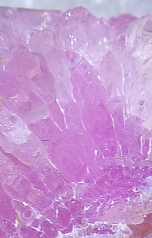Quartz Varieties Visible Spectra (generally 350 - 1100 nm)
The color of some varieties of quartz, SiO2, comes from metal ions substututing
either for silicon in the quartz structure, or in an site normally unoccupied
by ions (interstitial sites). In many of the varieties, the color comes
from small inclusions of other phases.
Images of the spectra of representative varieties
Amethyst-
Amethyst spectrum; Amethyst, AnahÝ
Mine, Bolivia. Data Files: Amethyst. Amethyst color
 develops in iron- containing quartz after exposure to ionizing radiation.
More information is available on our ametrine
page.
develops in iron- containing quartz after exposure to ionizing radiation.
More information is available on our ametrine
page.
CarnelianChrysoprase
- Chrysoprase spectrum; Chrysoprase,
Tulare County, California. Data Files: Chrysoprase 17884.
The color of chrysoprase is due to minute inclusions
of a Ni2+ layer silcate in the silica. In the case of the Australian
chrysoprase, the nickel silicate is a member of the talc group which been
identified both as willemseite, (Ni,Mg)3Si4O10(OH)2
and as kerolite, a variety of talc with a randomly stacked structure, in
the series, kerolite - nickel-kerolite
Citrine
- Citrine spectrum; Citrine = heated amethyst, GRR 3910, from Rio Grande do Sul, Brazil. 2.29 mm thick. The color
 is due to small aggregrates of iron oxide.
is due to small aggregrates of iron oxide.
JasperRose Quartz / Pink Quartz
-
Rose quartz spectrum; Rose quartz, Ramshorn
gulch, Tobacco Root Mountains, Montana. This is a diffuse reflectance spectrum.
Data Files: GRR 1787. The color comes from minute
fibers of an aluminum borosilicate phase contained in the quartz.
- Pink quartz spectrum. Crystal from Mount Mica, Maine, USA, 3.68 mm thick. Data Files: E perp c; E \\c.
The color of the pink quartz
 variety comes from P substutition in the silica. The quartz must be
irradiated by natural gamma rays to strip an electron from the oxygen
adjacent to the phosphorous presumably to form an O- group. Synthetic pink quartz has also been produced. A 3.12 mm thick Russian synthetic crystal has essentially the same optical spectrum as its natural counterpart
variety comes from P substutition in the silica. The quartz must be
irradiated by natural gamma rays to strip an electron from the oxygen
adjacent to the phosphorous presumably to form an O- group. Synthetic pink quartz has also been produced. A 3.12 mm thick Russian synthetic crystal has essentially the same optical spectrum as its natural counterpart
Smoky Quartz
-
Smoky quartz spectrum: Smoky Quartz, Saline Valley, California.
15.5 mm thick crystal. The color of smoky quartz is due to radiation-induced
color centers. One of the most prominent is centered on aluminum ions that
replace silicon in the tetrahedral site.
- Smoky quartz spectrum: Smoky Quartz, Crystal Peak, Teller County, Colorado. 5.79 mm thick slice from a dark black crystal. Data Files: E perpendicular to c; E parallel to c.
 Back
to the list of minerals
Back
to the list of minerals
 Back
to the Index of Data Files
Back
to the Index of Data Files
 Back
to the
Mineral Spectroscopy home page
Back
to the
Mineral Spectroscopy home page
last
upgraded 18-March-2024
 develops in iron- containing quartz after exposure to ionizing radiation.
More information is available on our ametrine
page.
develops in iron- containing quartz after exposure to ionizing radiation.
More information is available on our ametrine
page. develops in iron- containing quartz after exposure to ionizing radiation.
More information is available on our ametrine
page.
develops in iron- containing quartz after exposure to ionizing radiation.
More information is available on our ametrine
page. is due to small aggregrates of iron oxide.
is due to small aggregrates of iron oxide.  variety comes from P substutition in the silica. The quartz must be
irradiated by natural gamma rays to strip an electron from the oxygen
adjacent to the phosphorous presumably to form an O- group. Synthetic pink quartz has also been produced. A 3.12 mm thick Russian synthetic crystal has essentially the same optical spectrum as its natural counterpart
variety comes from P substutition in the silica. The quartz must be
irradiated by natural gamma rays to strip an electron from the oxygen
adjacent to the phosphorous presumably to form an O- group. Synthetic pink quartz has also been produced. A 3.12 mm thick Russian synthetic crystal has essentially the same optical spectrum as its natural counterpart Back
to the Index of Data Files
Back
to the Index of Data Files